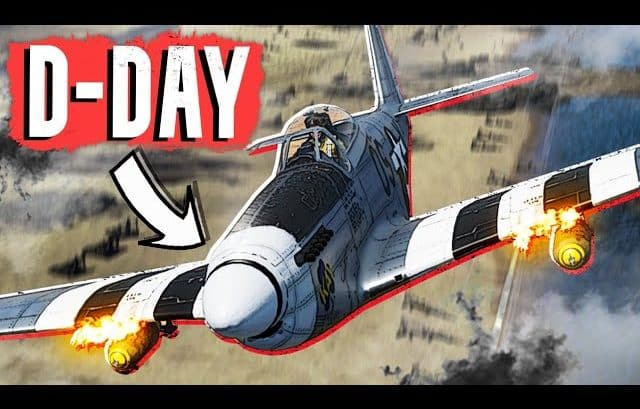During the summer of 1944, the fight in the battle of Europe is approaching a crucial moment. This moment would end up being June 6, 1944, D-Day.
As the soldiers on the ground prepare to storm the beaches, they would need cover from the air, from the brave men of the Eight Air Force, men like Ed McNeff.
High-Risk Endeavor
Low-level ground support was always a high-risk endeavor, as it would entail intense combat, close calls, and tragic losses.
During Operation Overlord (D-day) the P-51 pilots of the 355th Fighter Group would be needed in a new role, that of low-level bombing and attack to disrupt lines and eliminate defenses for the ground troops.
Low level-bombing not only left these fighters more exposed to anti-aircraft German fighters, but dive bombing was also not easy to master.
Difficult Attack Method
Dive bombing was a challenging attack method, involving calculation timing and feel for the tactic. Practice sessions would only be done a couple of weeks before D-day. Thus, pilots won’t have enough time to become experts in this tactic.
“You have to consider the effects of the wind angle of as angle of descent ad one of the big things would be in a Mustang is being able to get that pitch angle because if that pitch angle varies then the release of the bomb will vary the trajectory of the bomb,” said Stan Musick, a P-51 Mustang pilot. “In addition to that, you have the inevitable guy on the ground shooting at you.”
D-Day
On June 6th, 1944, as thousands of American, British, and Canadian soldiers were about to storm the beaches of France, the Mustangs of the 355th squadron took the skies.
The first mission of the day was uneventful. Poor cloud cover made much of the patrolling difficult. So, as the troop was hitting the beaches, the 355th saw little action other than simple flack. After returning, the Mustangs were loaded up, and refueled for another assignment, and it would be dive bombing.
Key Role
For this sortie, the P-51s of Ed’s group were outfitted with bombs, and they were instructed to hit vehicles and supplies that were headed to the beaches of France to fortify defenses.
The whole idea would be to try to suppress as much enemy fire as much as possible. Allied pilots tried to carve out enough of the beachhead to get a foothold into France so they can then advance.
Ed McNeff’s wingman for this particular mission was 20-year-old Thomas J. Foster. The pair crossed the channel on June 6th, arriving at their target area in southwest Paris.
McNeff and Foster made an error however and after hitting ground targets, drifted close together, and McNeff’s wing was accidentally torn by Foster’s 50-caliber machine gun. Fortunately, the low oxygen of the high altitude has suffocate the fire and although McNeff lacked brakes, he was able to get the plane back to England.
Beginning of the End
The next day, McNeff flew a new plane, a P-51 D with Foster as his wingman, dive-bombing 500-pound bombs, “I rolled in and went down, and we were trying to bomb a train. I went in, trying to drop my bombs, but he didn’t wait long enough and he came in behind me and I believe he got caught up in the explosion of my bombs.”
Lt. Foster was either caught up in either Ed’s bomb or his own, sending shrapnel on his own plane causing it to roll over, and go down. Foster was killed in action. June 7th, 1944 was the worst day for Ed’s squadron in terms of pilots’ loss. If there was something positive from all of this, then that would be the Allies on the ground winning.



